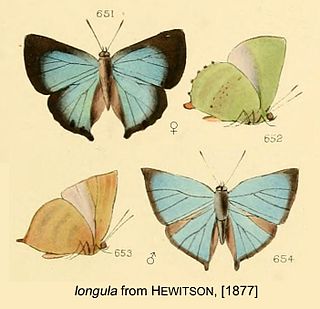Hypoecta is a genus of picture-winged flies in the family Ulidiidae.
Apamea longula is a moth of the family Noctuidae first described by Augustus Radcliffe Grote in 1879. It is found in western North America, mostly from California to the Great Plains. There are also a few records from areas north, including Alberta, Yukon, and Alaska.

Agaricus deserticola, commonly known as the gasteroid agaricus, is a species of fungus in the family Agaricaceae. Found only in southwestern and western North America, A. deserticola is adapted for growth in dry or semi-arid habitats. The fruit bodies are secotioid, meaning the spores are not forcibly discharged, and the cap does not fully expand. Unlike other Agaricus species, A. deserticola does not develop true gills, but rather a convoluted and networked system of spore-producing tissue called a gleba. When the partial veil breaks or pulls away from the stem or the cap splits radially, the blackish-brown gleba is exposed, which allows the spores to be dispersed.

Cyanophrys longula, the long-winged greenstreak, is a butterfly in the family Lycaenidae. The species was first described by William Chapman Hewitson in 1868. It is found in Mexico, with strays recorded from south-eastern Arizona. It has also been recorded from Hawaii.
Proeulia longula is a species of moth of the family Tortricidae. It is found in Chile in the Bío Bío and Maule regions.
Longula was a town in ancient times in the territory of the Volsci in central Italy. It was located south of Rome, and just north of the Volscian capital Antium.
Anapausoides longula is a species of beetle in the family Cerambycidae, and the only species in the genus Anapausoides. It was described by Breuning in 1973.

Pterolophia is a genus of longhorn beetles of the subfamily Lamiinae, containing the following species:
Ropica longula is a species of beetle in the family Cerambycidae. It was described by Breuning in 1939.
Sophronisca longula is a species of beetle in the animal family Cerambycidae. It was described by Stephan von Breuning in 1964.
Arixiuna longula is a species of beetle in the family Cerambycidae. It was described by Bates in 1881. It is known from Mexico.
Pterolophia instabilis is a species of beetle in the family Cerambycidae. It was described by Per Olof Christopher Aurivillius in 1922. It is known from Seychelles.
Pterolophia guineensis is a species of beetle in the family Cerambycidae. It was described by James Thomson in 1864, originally under the genus Alyattes.
Glenea longula is a species of beetle in the family Cerambycidae. It was described by Stephan von Breuning in 1964.
Brachycoryna longula is a species of leaf beetle in the family Chrysomelidae. It is found in Central America and North America.
Rhagonycha longula is a species of soldier beetle in the family Cantharidae. It is found in North America.
Cyclocephala longula is a species of rhinoceros beetle in the family Scarabaeidae. It is found in North America.
Osmia longula is a species of bee in the family Megachilidae. It is found in North America.

Kikihia longula, commonly known as the Chatham Island cicada, is a species of cicada that is endemic to New Zealand. This species was first described by George Hudson in 1950.



